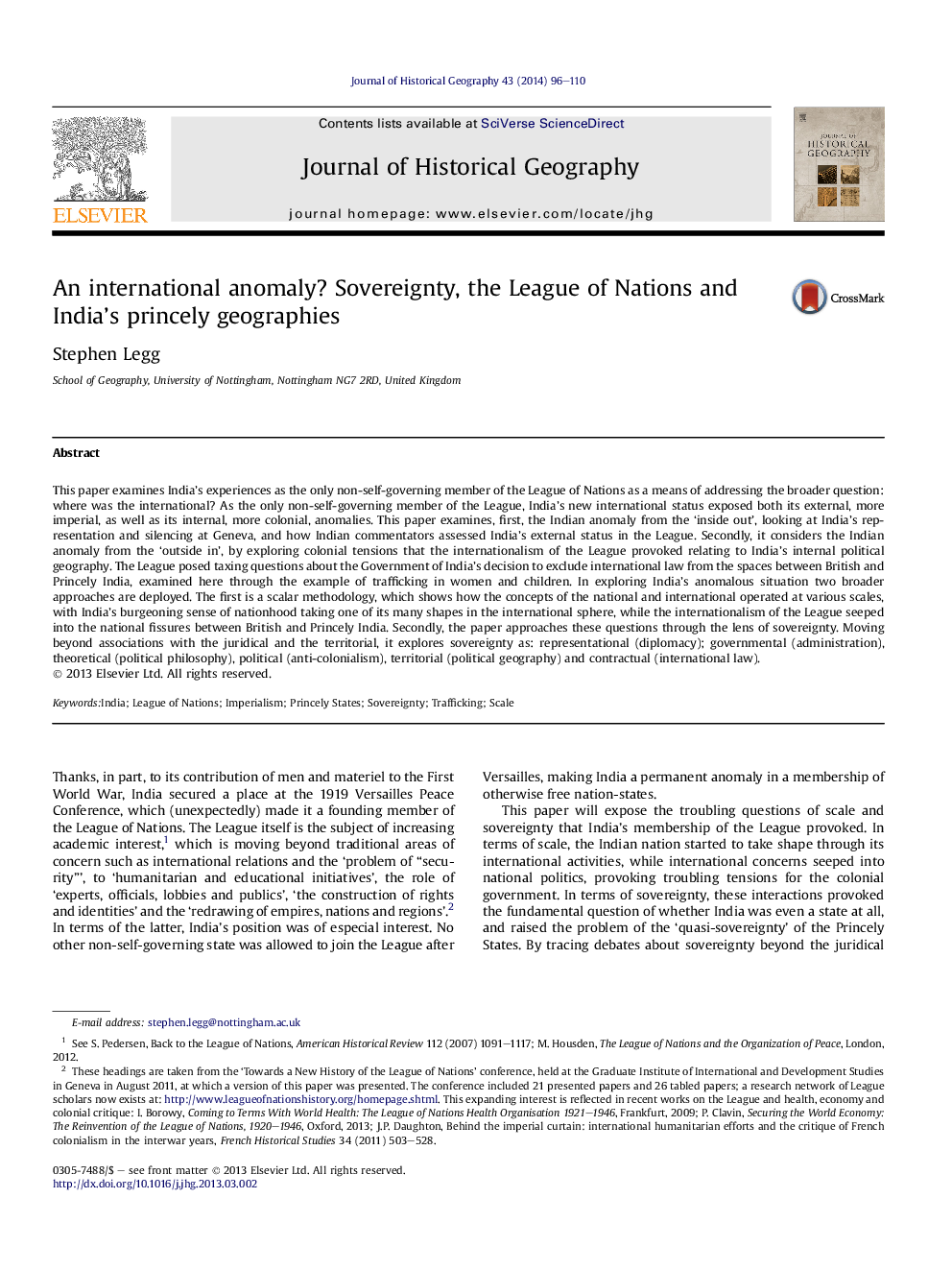| کد مقاله | کد نشریه | سال انتشار | مقاله انگلیسی | نسخه تمام متن |
|---|---|---|---|---|
| 7448215 | 1483982 | 2014 | 15 صفحه PDF | دانلود رایگان |
عنوان انگلیسی مقاله ISI
An international anomaly? Sovereignty, the League of Nations and India's princely geographies
ترجمه فارسی عنوان
یک بی نظمی بین المللی؟ حاکمیت، لیگ ملل و جغرافیای قومی هند
دانلود مقاله + سفارش ترجمه
دانلود مقاله ISI انگلیسی
رایگان برای ایرانیان
کلمات کلیدی
هند، لیگ ملل، امپریالیسم، شاهزاده ایالت، حق حاکمیت، قاچاق مقیاس،
ترجمه چکیده
این مقاله تجربیات هند را به عنوان تنها عضو غیرعضوی سازمان ملل متحد به عنوان وسیله ای برای رسیدگی به پرسش وسیع تر مورد بررسی قرار می دهد: کجا بود بین المللی؟ به عنوان تنها عضو غیر خودگردان اتحادیه، وضعیت جدید بین المللی هند، هر دو بی نظیر، امپریالیسم و دیگر انحرافات داخلی و استعماری خود را در بر می گیرد. در این مقاله اولا، انحراف هند از "بیرون"، به بررسی نمایندگی هند و خاموش شدن در ژنو، و چگونگی بررسی وضعیت خارجی هند در لیگ می پردازیم. ثانیا، آنومالی های هند را از "بیرون در"، با کشف تنش های استعماری که انترناسیونالیسم لیگ را در ارتباط با جغرافیای سیاسی داخلی هند تحریک می کند، در نظر می گیرد. این لیگ سوالات مالیاتی در مورد تصمیم دولت هند را مبنی بر حذف قوانین بین المللی از فضاهای بین انگلیس و شاهزاده هند، که از طریق نمونه ای از قاچاق زنان و کودکان مورد بررسی قرار گرفته است، مطرح می کند. در بررسی وضعیت غیرعادی هند، دو رویکرد گسترده تر به کار گرفته می شود. نخستین روش شناسی است که نشان می دهد که مفاهیم ملی و بین المللی در مقیاس های مختلف چگونه عمل می کنند، با توجه به روحیه رو به رشد هندوستان، یکی از شکل های بسیاری از آن در حوزه بین المللی است، در حالی که بین المللی بودن لیگ به شکاف های ملی رسیده است بین بریتانیا و شاهزاده هند. ثانیا، مقاله به این سوالات از طریق لنز حاکمیت نزدیک می شود. حرکت به خارج از ارتباطات با حقوقی و سرزمینی، آن را بررسی حاکمیت به عنوان: نمایندگی (دیپلماسی)؛ دولت (دولت)، نظری (فلسفه سیاسی)، سیاسی (ضد استعمار)، منطقه ای (جغرافیای سیاسی) و قراردادی (حقوق بین الملل).
موضوعات مرتبط
علوم انسانی و اجتماعی
علوم انسانی و هنر
تاریخ
چکیده انگلیسی
This paper examines India's experiences as the only non-self-governing member of the League of Nations as a means of addressing the broader question: where was the international? As the only non-self-governing member of the League, India's new international status exposed both its external, more imperial, as well as its internal, more colonial, anomalies. This paper examines, first, the Indian anomaly from the 'inside out', looking at India's representation and silencing at Geneva, and how Indian commentators assessed India's external status in the League. Secondly, it considers the Indian anomaly from the 'outside in', by exploring colonial tensions that the internationalism of the League provoked relating to India's internal political geography. The League posed taxing questions about the Government of India's decision to exclude international law from the spaces between British and Princely India, examined here through the example of trafficking in women and children. In exploring India's anomalous situation two broader approaches are deployed. The first is a scalar methodology, which shows how the concepts of the national and international operated at various scales, with India's burgeoning sense of nationhood taking one of its many shapes in the international sphere, while the internationalism of the League seeped into the national fissures between British and Princely India. Secondly, the paper approaches these questions through the lens of sovereignty. Moving beyond associations with the juridical and the territorial, it explores sovereignty as: representational (diplomacy); governmental (administration), theoretical (political philosophy), political (anti-colonialism), territorial (political geography) and contractual (international law).
ناشر
Database: Elsevier - ScienceDirect (ساینس دایرکت)
Journal: Journal of Historical Geography - Volume 43, January 2014, Pages 96-110
Journal: Journal of Historical Geography - Volume 43, January 2014, Pages 96-110
نویسندگان
Stephen Legg,
